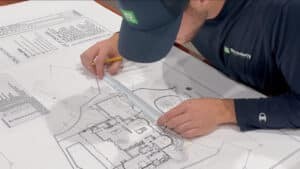
What’s the Difference Between a Landscape Architect and Designer?
Landscape architects and landscape designers are titles for individuals involved in designing outdoor spaces, but the two roles have some key differences. Here are the main distinctions:
1. Education and Licensing: To qualify to become a licensed landscape architect in Florida requires specific education and experience. Before sitting for the licensing examination, it requires “a Landscape Architectural Accreditation Board (LAAB) accredited degree in landscape architecture or six years practical experience under a registered landscape architect,” according to the Florida Department of Professional Regulation. Then, they must pass the Landscape Architecture Registration Examination (LARE) and the Florida Plants & Materials exam. On the other hand, landscape designers may or may not have formal education in landscape design, horticulture, or related fields and are not required to have a license to practice.

Landscape designers focus on small-scale residential projects involving plant selection and layout. Many garden centers have someone on staff with a passion for designing garden beds that can provide options for well-suited plant material that helps the client and the establishment sell more plants. As a result, landscape designers tend to have more hands-on experience with retail clientele, providing quick answers and solutions compared to a landscape architect’s more deliberative process incorporating greater technical and regulatory knowledge.
3. Design Approach: Landscape architects tend to take a more holistic approach to design, considering not only aesthetics but also the environmental, social, and ecological aspects of a project. They may work closely with other professionals, such as civil engineers or architects, to ensure the design integrates seamlessly with the overall project. Landscape designers are more sales-focused on creating visually pleasing outdoor spaces. Landscape architects and designers can provide landscape designs through hand sketches and use CAD and other 3D design tools.
4. Significance of the Title: In Florida, landscape architect is a protected professional title, meaning it can only be used by individuals with the necessary qualifications and licenses. A landscape designer isn’t a restricted term, and individuals with various levels of expertise may use this title.
Here at Rockaway, our landscape architects and designers work together, complementing each other’s competencies to serve the best interests of our clients regardless of the scope of their projects. From our office in Atlantic Beach and satellites throughout Northeast Florida, Rockaway Inc proudly serves both commercial and residential landscape design, maintenance, lawn care, irrigation, and outdoor living carpentry client needs in Jacksonville, St Augustine, Atlantic Beach, Neptune Beach, Jacksonville Beach, Ponte Vedra, Nocatee, St. Johns, and Fernandina Beach.
